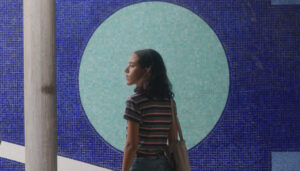By: Olivia Visser, Copy Editor
Lhuḵw’lhuḵw’áyten (Burnaby Mountain) has been home to hən̓q̓əmin̓əm̓ and Sḵwx̱wú7mesh people for thousands of years. Today, the mountain is known to many as the location of SFU’s main campus — a decision that was made without permission from Indigenous peoples. Although the university is now working towards reconciliation and decolonization, its very existence is a byproduct of colonialism. And while SFU’s walkways are adorned with Indigenous artwork, how many people stop to learn the history behind these pieces?
The Bill Reid Centre recently developed a virtual walking tour of Indigenous art on campus, offering supplemental background information for each featured piece. The ímesh mobile app, which means “to walk” in Sḵwx̱wú7mesh snichim, contains maps, Coast Salish place names, photos, and detailed descriptions about the artwork on display across SFU. The Bill Reid Centre describes ímesh as “a step toward decolonizing the university and the surrounding landscape.” You don’t have to visit campus to enjoy the app or its corresponding webpage, but I’d encourage those interested to pick a quiet afternoon and explore the Art Walking Tour with a renewed sense of mindfulness.
If you’ve ever visited the 3rd floor of the Academic Quadrangle (AQ), you’ve likely walked past the striking marble sculptures created by Iljuwas Bill Reid (Raven-Wolf Clan, Haida Nation). Known as the Spirit of Haida Gwaii Busts, Bear Mother (1991) and Dogfish Woman (1991) stand side-by-side with distinguished gazes, overlooking the bustle of the AQ. As noted in the ímesh app, both sculptures are based on popular Haida legends. Bear Mother is the story of a berry picker who was forced to marry the son of a grizzly bear chief after disrespecting the local bears. As a result, her children were born with both human and bear features. The legend “emphasizes the importance of honouring and respecting animals” and “deals with the subjects of transformation and travel between the human and non-human worlds.”
Dogfish Woman follows a legend that’s “difficult to trace” these days. The app includes a transcription of Franz Boas’ retelling, which echoes similar themes to Bear Mother. Accordingly, a woman made fun of a dogfish while travelling, so she was brought beneath the sea to learn that “the dogfish were really people.” After spending some time underwater with the dogfish, the woman grew fins across her body, and never returned to her family on land. As described in the app, the story addresses “barriers between species, and lost love.”
Stepping into the Saywell Hall Atrium, you’ll be greeted by a plethora of vivid art pieces. One of the most striking works is Frog Constellation (1995), which stands outside the Museum of Archaeology & Ethnology. Frog Constellation is a towering cedar sculpture depicting an old Haida love story involving a frog king. Frogs are “spirit helpers of the shaman,” according to the ímesh write-up. Haida artist James Hart got the idea for his sculpture from a “small shamanic piece collected on the Northwest Coast in the mid-19th century.” Shamans are significant spiritual figures across global cultures. In Northwest Coast society, they “cure the sick and ensure that runs of salmon and other game were plentiful.” Hart explains “the frog is one of [his] family’s crests,” making the tribute personally significant to him.
Tucked into the southwest corner study area of the AQ 3rd floor are the Cape Dorset Prints (1966, 1971). Three prints from three Inuit artists showcase intricate textures and flowy colour gradients, “illustrating the interplay between spirits, animals, and humans.” Pauta Saila, Pitseolak Ashoona, and Ikayukta Tunnillie are Inuit stonecut artists. Stonecut is a complex form of printmaking central to Kinngait (Cape Dorset) artwork. Artists trace a drawing onto stone before cutting away the remaining surface area to create a raised image. The ímesh app states commercial print-making was introduced to Inuit communities in the 1950s, but they had been adorning hides, garments, and amulets with artwork for “over a thousand years.”
There are plenty of other pieces to browse through on the ímesh app, so be sure to check it out. While the Bill Reid Centre mentions the app only offers “a brief introduction to the artist and the cultural knowledge that has informed their work,” they encourage viewers to continue a personal pursuit of research.
Download the ímesh app for access to the map-guided art walk, or visit the website at sfu.ca/brc/our-work/imesh-mobile-app/indigenous-art-walk.html.














